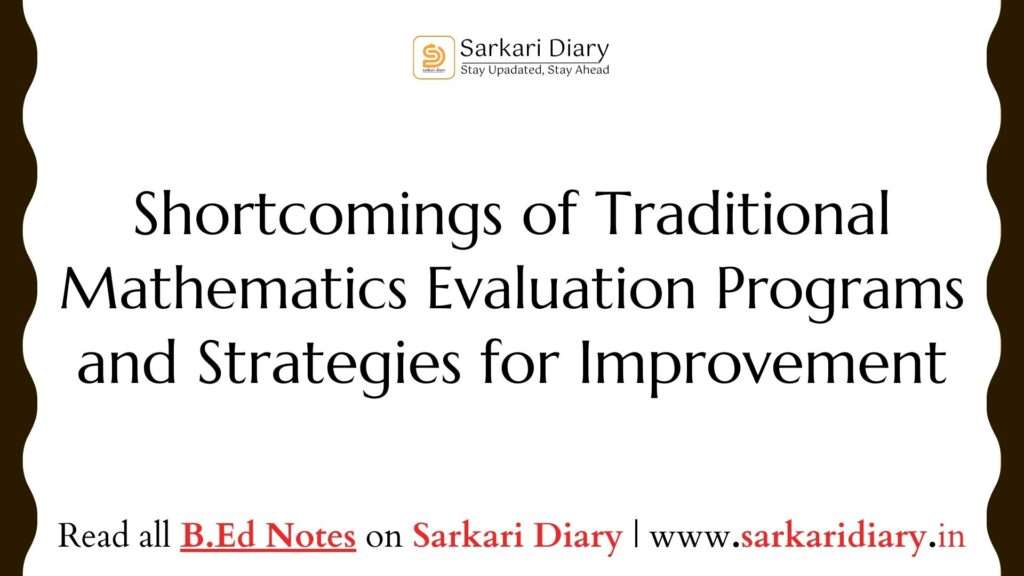Mathematics evaluation programs play a crucial role in assessing student learning, informing instructional decisions, and identifying areas for improvement. However, many traditional programs suffer from shortcomings that limit their effectiveness. This essay will explore these shortcomings and propose strategies to create a more comprehensive and beneficial evaluation system.

Major Shortcomings of Traditional Programs
- Overemphasis on Standardized Testing: Standardized tests have become a cornerstone of many evaluation programs. While they offer a snapshot of student achievement on specific skills, they often lack depth and fail to capture the nuances of mathematical understanding. These tests typically focus on procedural fluency (the ability to perform calculations) at the expense of conceptual understanding (the ability to explain why procedures work and how they connect to broader mathematical ideas). Students may excel at manipulating numbers on a test without truly grasping underlying concepts, leading to difficulties applying their knowledge to novel situations.
- Limited Assessment Methods: Traditional programs often rely heavily on multiple-choice tests and short answer questions. These formats limit students’ ability to demonstrate their problem-solving skills, creativity, and reasoning processes. Students become adept at test-taking strategies rather than developing a true understanding of mathematics.
- Focus on Scores over Learning: The emphasis on test scores can create a high-stakes environment where the focus shifts from learning to achieving a specific grade. This can lead to anxiety, test-taking fatigue, and a disengagement with mathematics for some students. Additionally, a singular focus on scores doesn’t provide a holistic picture of student learning progress.
- Lack of Formative Assessment: Traditional programs often prioritize summative assessments, which measure student learning at the end of a unit or course. There’s a gap in formative assessment, which provides ongoing feedback to inform instruction and identify areas where students need additional support. Without regular formative assessment, teachers may miss opportunities to adjust their teaching and address student misconceptions in real-time.
- Inequity and Bias: Standardized tests can be culturally biased, favoring students from certain backgrounds who may have had more exposure to the tested concepts. Additionally, traditional methods may disadvantage students who learn differently or have difficulty expressing themselves in a written format.
Strategies for Improvement
- Multifaceted Assessment Strategies: A well-rounded evaluation program should use a variety of assessment methods to capture the full spectrum of mathematical skills. This can include:
- Open-ended tasks: Requiring students to explain their reasoning and problem-solving approaches.
- Performance assessments: Allowing students to demonstrate their knowledge and skills through projects, presentations, or experiments.
- Self-assessments: Enabling students to reflect on their learning progress and identify areas for improvement.
- Observations: Teachers can observe students’ work habits, collaboration skills, and participation in class discussions to gain insights into their mathematical thinking.
- Portfolios: Collecting student work over time to show their learning trajectory and growth in understanding.
- Shifting the Focus to Learning: Evaluation should be used to inform instruction and support student learning, not just to assign grades. Teachers can use formative assessments to identify individual student needs and adjust their teaching accordingly. Providing clear and actionable feedback that helps students understand their strengths and weaknesses is crucial.
- Incorporating Technology: Technology can be a powerful tool for formative assessment. Online platforms can provide students with immediate feedback on their work and personalized practice opportunities. Interactive simulations and games can make learning more engaging and help students visualize mathematical concepts.
- Promoting Equity and Accessibility: It’s important to use assessments that are fair and inclusive for all students. This may involve providing alternative assessment formats for students with learning disabilities or offering accommodations for students who struggle with written expression.
- Collaboration and Professional Development: Teachers can benefit from collaborating with colleagues to share best practices in assessment and develop a shared understanding of effective evaluation methods. Professional development programs can equip teachers with the skills and strategies needed to implement a more comprehensive evaluation system.
Conclusion
Moving beyond the limitations of traditional evaluation programs is essential. By incorporating a wider range of assessment methods, focusing on learning over scores, and promoting equity and accessibility, we can create a system that empowers students, informs instruction, and supports a deeper understanding of mathematics. This shift requires collaboration among educators, assessment developers, and policymakers. By working together, we can create a more meaningful and effective evaluation system that fosters a love of learning and a strong foundation in mathematics for all students.